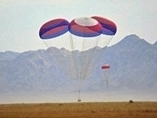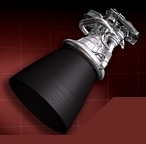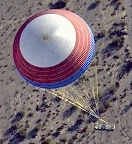
->Latest News About the CEV Program!
(news by reverse chronological order, recentest first)
. August 2010. The Five-Segment Solid-Rocket-Motor Successfully Tested at Cold Temperatures
NASA and ATK successfully tested the five-Segment
Solid Rocket Motor (SRM) under cold conditions, by 40 degrees F (5° C) on Aug. 31, 2010. The stationary firing of the first-stage development solid rocket motor, dubbed
DM-2, was the most heavily instrumented solid rocket motor test in NASA history. The first development motor test had occurred last year at ambient temperature. Although similar to the solid rocket boosters that help power the Space Shuttle
to orbit, the five-segment development motor includes several upgrades and
technology improvements like the addition of a fifth segment, a larger nozzle
throat, and upgraded insulation and liner
. May 2010. The Orion Capsule Launch Abort System Successfully Tested!
By May 6th, 2010, the takeoff and ascent launch abort system for the Orion capsule has been successfully tested in New Mexico. The system, akin to the Apollo program system is composed of a extracting motor taking the capsule away from the launcher, a steering motor controlling the capsule attitude hereafter, and a jettison motor getting the abort system distant from the capsule' nose cone allowing for the parachutes to extract. Such a test occurred despite that the Obama administration scraped the Constellation program, only allowing the Orion capsule to serve like a life boat to the International Space Station (ISS)
. June 2009. A Virtual Flight of The Orion to the ISS Performed!
Mission controllers, ground operators and engineers, at multiple NASA centers performed a virtual launch and flight of a Orion mission, ferrying astronauts to the International Space Station. Their purpose of a virtual mission was to simulate the mission planning processes and utilize new software designed to reduce mission certification time. Instead of numbers churning across the monitor screens, the data looked more like video game animations
 | a view of a test of the parachutes cluster of the Ares-I reusable launcher. picture U.S. Army Yuma Proving Grounds |
. May 2009. Chutes Tests Continuing for the Ares-I!
NASA successfully keeps conducting a series of tests about the main cluster parachutes of the Ares I rocket. Such parachutes are those which are to slow the rapid descent of the spent first-stage motor of the Ares I rocket and permit its recovery for use on future flights. The chutes are the the largest rocket parachute ever manufactured, measuring 150 feet (45 m) in diameter and weighing 2,000 pounds (1 ton) each. The main chutes are following the extraction of a pilot parachute and a drogue parachute as they are deployed in a cluster to provide a soft landing of the spent rocket in the ocean. The Ares I will fall from a higher altitude than the Space Shuttle boosters. Tests are conducted at the U.S. Army Yuma Proving Grounds, in the heart of the geat Sonoran Desert
. April 2009. The Orion Spacecraft Capacity Trimmed Down to 4 Only!
NASA trimmed down the crew size of the Orion spacecraft from 6 to 4, should the craft still be aiming 2015 like the dateline for its debuts. Two parallel designs were developed until now, as a 6-person model would have been used to ferry crews to and back from the ISS, and a 4-person one would have targeted the return of man to the Moon. NASA is not giving up the six-crew possibility however as the agency said that 'We will need it someday. We don't need it early.' Such a decision will allow the USA to size down its agenda and funding it would have needed in terms of two different versions of the new space vehicle. To fill a gap of 5 years between the retirement of the Space Shuttle fleet -at the best by 2011- and the entry of the Orion in service -by 2015- NASA would have to rely on Russian Soyuz, Russian, European and Japan cargo ships, or US-build commercial cargo spacecraft like the 'Dragon' or a rocket developed by a private firm. The Constellation program -the continuity of which is subject to be questioned by the new, Obama administration, will likely get Congress support and funding only if its developers are able to streamline their agenda and projects
. February 2009. The Apollo-Era O&C Building at the Kennedy Space Center Updated to Process the Crew and Service Modules
NASA, Lockheed Martin Space Systems Co., Space Florida and the state of Florida have renovated the historic 'Operations and Checkout Building', or O&C, high bay at the Kennedy Space Center, as the updated facility will serve as the final assembly and checkout facility for the Orion crew exploration vehicles, which includes the crew and service modules. The facility had been once used to process space vehicles in the Apollo era. Everything in the building got updated, except the basic structure
. September 2008. The 'Ares I' Launcher Authorized to Development by NASA
NASA gave its preliminary agreement to the development of the Ares I launcher. Ares I was found matching all the technical, financiary, and safety requirements. Another review -called a 'delta' one- will be performed next year specifically about the lasting question of the post-launch vibrations as a 'structural' review is to be then performed in March 2011. The Ares I, at that time, will have had its conception entirely tested. A 'preliminary' review for the Orion capsule is scheduled for the end of 2009
 | a view of the J-2x engine. picture NASA |
. May 2008. The Upper Stage Engine in Their Earlier Tests
The Ares J-2X engine, which is to power the upper stages of the Ares I and Ares V rockets, first tested in its early stages of development
. December 2007. The Lunar Lander to be Named 'Altair'
NASA chosed the name 'Altair' like the name of the future lunar lander of the Constellation program. The name was chosen by reference to that the Latin name of the constellation Altair is the brightest star for, Aquila, the Eagle, that is, is meaning "eagle", which is reminiscent of the Lunar Exploration Module (LEM), which was the craft used by Neil Armstrong and Buzz Aldrin when they were in 1969 the first human crew ever to land on the Moon
 | the chute for the Ares boosters. picture NASA/MSFC |
. November 2007
NASA successfully tested the 1-ton, 150-foot wide parachute, on Nov. 15th, 2007, which will be used to secure the Constellation Program solid rocket boosters back to surface after liftoff. This chute is the biggest ever used at NASA! The Ares I and V solid rocket boosters are derived from the boosters used for the current Space Shuttle, as the ones for the Ares I will be added with a fifth segment. The new chutes will be made of Kevlar as the Shuttle's ones are made of nylon, as three chutes will be used for each booster (preceded by a small pilot chute which will have extracted a 68-ft wide rogue chute aimed at maneuvering the booster into a vertical position
. November 2007. The Kennedy Space Center Getting Ready for the Constellation Program!
The Kennedy Space Center assets are progressively getting assigned to the new elements and working of the Constellation program. The launch pad 39B, thus, will be re-used for the Ares I launches, as launch pad 39A will be converted into a one for the Ares V, cargo rocket. The Vehicle Assembly Building, as far as it is concerned, will retain its role for stacking the missions. Launch Control Center Firing Room 1 will be updated too as will other facilities of the KSC, like the 'Assembly and Refurbishment Facility' -processing now the Space Shuttle solid rocket boosters- as the 'Parachute Refurbishment Facility', a new facility will handle the return parachutes of the program. A new mobile launch platform will be designed for the program, as NASA decided to stick to this concept, and the platforms will keep being transported to the launch pads through reinforced crawler-transporters
. August 2007. Boeing to Build the Ares I Upper Stage, as Alliant Technsystems to Built the Solid Rocket Boosters to be Used by the Program
It's Boeing Co. which will build the upper stage of the Ares I, as NASA had attributed to Alliant Technsystems (or ATK), Brigham City, Utah, the design, testing and development of the solid rocket boosters which will be used like the first stage of the Ares I, and part of the first stage of the Ares V
. July 2007. Pratt and Whitney Chosen to Build the J-2X Engine
NASA has chosen Pratt and Whitney Rocketdyne Inc. for design, development, testing and evaluation of the J-2X engine, which power the upper stages of the Ares I and Ares V launchers, through Dec. 2012. The J-2X is an evolved version of two engines (the J-2, and the J-2S) which had already been produced or designed by Pratt and Whitney. The J-2 engine had been used by the Saturn 1B and Saturn V rockets
. June 2007. System Requirements Over Now!
NASA has wrapped up six months of system requirements reviews for the Constellation program, as, albeit the basic program architecture remains unchanged, it now has a firmer foundation. A "baseline synchronization" on May 23 followed individual systems requirements reviews, or SRRs, as, as far a Moon base is concerned, lunar architecture system requirements review is expected in spring of 2009. Next steps for the Constellation Program are a preliminary design review series in summer 2008 and a critical design review series in early 2010.
. March 2007. System Requirements En Cours!
NASA, in collaboration with its prime contractor Lockheed Martin, established its system requirements for the Orion project. Such a milestone allows as the basis for ongoing design analysis work and systems testing. An overall review of requirements had been performed for the Constellation program, generally, last November 2006, as such reviews similar to the Orion one, will be performed later in spring for ground and mission operations systems which are to support the program's launch systems and space flight operations ground infrastructure. The system requirements data were reviewed by agency and contractor scientists and engineers from across the country. Another, full program, review will occur later to update baseline requirements
. September 2006. It's Lockheed Martin Corp. That NASA Chooses As the Prime Contractor For the CEV 'Orion'!
It's Lockheed Martin Corp. that NASA has chosen as the prime contractor for the Crew Exploration Vehicle -or Orion. Despite that Boeing could build upon its experience with the Apollo program, it's eventually Lockheed Martin Corp. which will build NASA's next generation vehicle. The construction of the re-entry thermal shield of the CEV has been awarded by NASA to The Boeing Company, Huntington Beach, Calif., in September, on the other hand. The CEV is slated to re-enter at speeds similar to those experienced by the space shuttle - 16,700 miles an hour (27,000 km/h) when it will be back from the Earth's orbit. Returning Moon, it will at speeds of about 25,000 miles an hour (40,000 km/h) and experience heating about five times higher. The majority of the construction of the Orion capsulework will be at the Johnson Space Center in Houston and final assembly at the Kennedy Space Center. Lockheed Martin had built several unmanned probes during the space age, like the Viking probes or the Mars Reconnaissance Orbiter
 | the Orion capsule with the service module. picture NASA |
. Aug. 2006. NASA Names New Crew Exploration Vehicle 'Orion'
NASA named 'Orion' the Crew Exploration Vehicle. The CEV is planned to perform its first flight no later than in 2014, with a first flight to the Moon no later than 2020. Orion will be able to carry cargo and up to 6 crewmembers to the International Space Station (ISS) as it will carry four persons to the Moon. The characteristics of the craft begin to be better known too, as it will be 16.5 feet in diameter and have a mass of about 25 tons. It will have an internal volume 2.5 times the one of an Apollo capsule. The CEV was named 'Orion' from the famed, easily identifiable constellation
. Summer 2006. NASA Named Constellation Program Two Launchers
NASA named the Constellation program launchers like Ares I and Ares V. 'Ares' was the Greek name for Mars. It's the crew launch vehicle which will be called Ares I as the cargo launcher will be Ares V. 'I' and 'V' pay homage to the Saturn I and Saturn V Apollo program rockets
-- This vehicle will be carried into space by Ares I, which uses a single five-segment solid rocket booster, a derivative of the space shuttle's solid rocket booster, for the first stage. A liquid oxygen/liquid hydrogen J-2X engine derived from the J-2 engine used on Apollo's second stage will power the crew exploration vehicle's second stage. The Ares I can lift more than 55,000 pounds to low Earth orbit
. June 2006. NASA Awarded Pratt & Whitney Rocketdyne, Inc. of Canoga Park, Calif. the Development of the J-2X CEV Launchers Engine
NASA awarded Pratt & Whitney Rocketdyne, Inc. of Canoga Park, Calif. the developement of the J-2X CEV launchers engine. The J-2X engine is planned to power the the crew launch vehicle's upper stage and the Earth departure stage of the cargo launch vehicle. It's the RS-68 engine, on the other hand, which will power the core stage of the CEV's heavy lift cargo launch vehicle, intended to carry large payloads to the moon. NASA's initial decision was to use a derivative of the space shuttle main engine